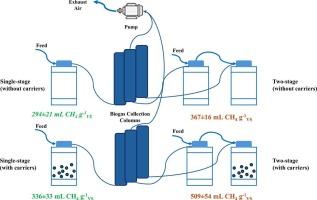Anaerobic co-digestion of sewage sludge and food waste: staging and carriers enhance system performance and process stability
Q1 Environmental Science
引用次数: 0
Abstract
Sewage sludge (SS) generated from biological wastewater treatment requires adequate treatment. Anaerobic digestion of SS remains a preferred approach, but suffers from slow hydrolysis and low biogas production. Co-digestion with food waste (FW) could improve hydrolysis rate and nutrients balance, leading to improved biogas production. This study investigates the performance of eight semi-continuous anaerobic systems: single-stage (mono-and co-digestion) and two-stage (mono- and co-digestion). All the systems were operated with and without carriers (Anox Kaldness K5 for biofilm support) under mesophilic conditions for 205 days and at a total hydraulic retention time (HRT) of 20 days. In SS mono-digestion, biogas production averaged 230 ± 31 and 538 ± 40 mLbiogas L−1 d−1 in single- and two-stage systems with carriers, respectively. A maximum specific methane yield of 509 ± 54 and 367 ± 16 mL CH4 g−1vs was measured in two-stage systems with and without carriers, respectively treating 20 % SS and 80 % FW (on wet weight basis) on day 134. Carriers improved biogas production and process stability by reducing volatile fatty acids (VFA) accumulation, with two-stage system with carriers achieves the highest cumulative biogas production and operational stability.

厌氧共消化污泥和食物垃圾:分级和载体提高系统性能和过程稳定性
污水生物处理产生的污泥需要适当的处理。SS的厌氧消化仍然是首选的方法,但存在水解缓慢和沼气产量低的问题。与食物垃圾(FW)共消化可以提高水解率和营养平衡,从而提高沼气产量。本研究考察了8种半连续厌氧系统的性能:单阶段(单和共消化)和两阶段(单和共消化)。在中温条件下,所有系统在有和没有载体(Anox Kaldness K5作为生物膜载体)的情况下运行205天,总水力停留时间(HRT)为20天。在SS单消化系统中,在单级和两级载体系统中,平均产气量分别为230±31和538±40 ml沼气L - 1 d - 1。在有载体和无载体的两级系统中,分别处理20% SS和80% FW(以湿重为基础),在第134天测得的最大甲烷比产率为509±54和367±16 mL CH4 g−1vs。载体通过减少挥发性脂肪酸(VFA)的积累提高了沼气产量和工艺稳定性,采用两级载体系统实现了最高的累积沼气产量和运行稳定性。
本文章由计算机程序翻译,如有差异,请以英文原文为准。
求助全文
约1分钟内获得全文
求助全文
来源期刊

Bioresource Technology Reports
Environmental Science-Environmental Engineering
CiteScore
7.20
自引率
0.00%
发文量
390
审稿时长
28 days
 求助内容:
求助内容: 应助结果提醒方式:
应助结果提醒方式:


